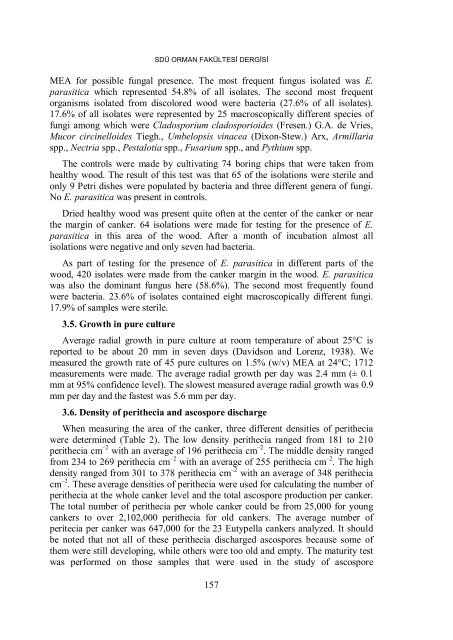sdu faculty of forestry journal special edition 2009 - Orman Fakültesi
sdu faculty of forestry journal special edition 2009 - Orman Fakültesi
sdu faculty of forestry journal special edition 2009 - Orman Fakültesi
Create successful ePaper yourself
Turn your PDF publications into a flip-book with our unique Google optimized e-Paper software.
SDÜ ORMAN FAKÜLTESİ DERGİSİ<br />
MEA for possible fungal presence. The most frequent fungus isolated was E.<br />
parasitica which represented 54.8% <strong>of</strong> all isolates. The second most frequent<br />
organisms isolated from discolored wood were bacteria (27.6% <strong>of</strong> all isolates).<br />
17.6% <strong>of</strong> all isolates were represented by 25 macroscopically different species <strong>of</strong><br />
fungi among which were Cladosporium cladosporioides (Fresen.) G.A. de Vries,<br />
Mucor circinelloides Tiegh., Umbelopsis vinacea (Dixon-Stew.) Arx, Armillaria<br />
spp., Nectria spp., Pestalotia spp., Fusarium spp., and Pythium spp.<br />
The controls were made by cultivating 74 boring chips that were taken from<br />
healthy wood. The result <strong>of</strong> this test was that 65 <strong>of</strong> the isolations were sterile and<br />
only 9 Petri dishes were populated by bacteria and three different genera <strong>of</strong> fungi.<br />
No E. parasitica was present in controls.<br />
Dried healthy wood was present quite <strong>of</strong>ten at the center <strong>of</strong> the canker or near<br />
the margin <strong>of</strong> canker. 64 isolations were made for testing for the presence <strong>of</strong> E.<br />
parasitica in this area <strong>of</strong> the wood. After a month <strong>of</strong> incubation almost all<br />
isolations were negative and only seven had bacteria.<br />
As part <strong>of</strong> testing for the presence <strong>of</strong> E. parasitica in different parts <strong>of</strong> the<br />
wood, 420 isolates were made from the canker margin in the wood. E. parasitica<br />
was also the dominant fungus here (58.6%). The second most frequently found<br />
were bacteria. 23.6% <strong>of</strong> isolates contained eight macroscopically different fungi.<br />
17.9% <strong>of</strong> samples were sterile.<br />
3.5. Growth in pure culture<br />
Average radial growth in pure culture at room temperature <strong>of</strong> about 25°C is<br />
reported to be about 20 mm in seven days (Davidson and Lorenz, 1938). We<br />
measured the growth rate <strong>of</strong> 45 pure cultures on 1.5% (w/v) MEA at 24°C; 1712<br />
measurements were made. The average radial growth per day was 2.4 mm (± 0.1<br />
mm at 95% confidence level). The slowest measured average radial growth was 0.9<br />
mm per day and the fastest was 5.6 mm per day.<br />
3.6. Density <strong>of</strong> perithecia and ascospore discharge<br />
When measuring the area <strong>of</strong> the canker, three different densities <strong>of</strong> perithecia<br />
were determined (Table 2). The low density perithecia ranged from 181 to 210<br />
perithecia cm –2 with an average <strong>of</strong> 196 perithecia cm –2 . The middle density ranged<br />
from 234 to 269 perithecia cm –2 with an average <strong>of</strong> 255 perithecia cm –2 . The high<br />
density ranged from 301 to 378 perithecia cm –2 with an average <strong>of</strong> 348 perithecia<br />
cm –2 . These average densities <strong>of</strong> perithecia were used for calculating the number <strong>of</strong><br />
perithecia at the whole canker level and the total ascospore production per canker.<br />
The total number <strong>of</strong> perithecia per whole canker could be from 25,000 for young<br />
cankers to over 2,102,000 perithecia for old cankers. The average number <strong>of</strong><br />
peritecia per canker was 647,000 for the 23 Eutypella cankers analyzed. It should<br />
be noted that not all <strong>of</strong> these perithecia discharged ascospores because some <strong>of</strong><br />
them were still developing, while others were too old and empty. The maturity test<br />
was performed on those samples that were used in the study <strong>of</strong> ascospore<br />
157








